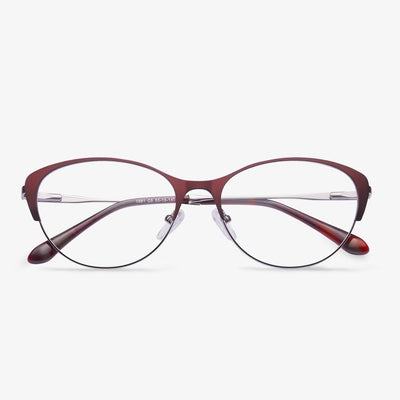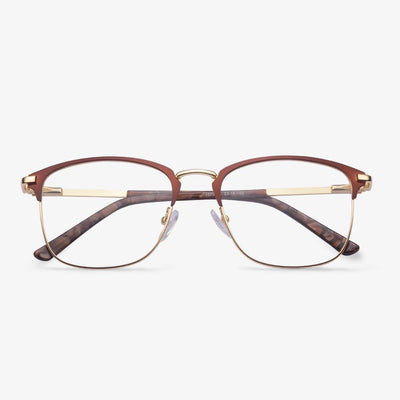What Should You Do If Your Glasses Are Broken?
Adjust the frame by yourself. If your frame is tilted, place your glasses on a flat surface to determine which arm is higher than the other. If the right arm looks raised, you'll need to use pliers to bend the left arm down at the hinge. Or, if the left arm is raised, bend the right arm at the hinge. You can bend your metal-framed arms inward. You can turn the nose pad inward if the glasses slip under your nose. To make the frames more flexible, you can heat them with a hairdryer. If the metal frame has broken into pieces, you may need to take it to a professional. However, if your metal frames just bend, you may be able to repair them by yourself.
Should I wear glasses all the time for myopia?
Wearing glasses is more to correct your vision and protect your eyes, so as not to worsen myopia. If you are nearsighted but don't wear glasses, it will have a lot of impact on your eyes. First of all, after a person is nearsighted, seeing distant things requires a lot of adjustments to the eyeballs, which will make your eyes tired easily. Over time, your myopia will increase quickly. When we are nearsighted, sometimes the myopia of the two eyes is not the same. If we do not wear glasses and correct vision, this will affect the normal development of vision. The difference between the powers of the two eyes may become larger and larger, which is easy to cause a squint. After myopia, if you want to see far away things clearly, you need to squint your eyes harder to see clearly. Therefore, some nearsighted eyes often squint when they are not wearing glasses. However, the action of squinting will cause the upper eyelid to form a pressure on the eyeball, and squinting for a long time can easily cause amblyopia. Squinting your eyes for a long time will also make your eyes smaller and affect your appearance. Therefore, once your myopia exceeds 200 degrees, you must wear glasses in time.
Bifocal vs Varifocal Glasses: What Are Their Differences?
The above part has introduced some basic information about bifocal glasses and varifocal glasses. So, what are their differences?
- Bifocal glasses have two different prescriptions in one lens, while varifocal glasses have three different prescriptions in one lens.
- There is a distinct line between different prescriptions in bifocal glasses. Varifocal glasses allow getting through other prescriptions smoothly.
- Varifocals can give you a vision at any distance.
- Bifocal glasses are more cost-effective than varifocal glasses.
However, they also have some similarities. Both glasses can be used to correct presbyopia vision. So, when you choose glasses, you can decide to choose bifocal glasses or varifocal glasses based on your needs. If you want to get a pair of corrective glasses online, Koalaeye Optical is recommended. It is an online glasses store and provides all kinds of eyeglasses, sunglasses and frames. In addition, these glasses are stylish and come at a cheap price.
What Do Pinhole Glasses Do?
Pinhole glasses are often used by eye doctors who use them as a diagnostic tool to quickly check for vision impairments. Of course, pinhole glasses are sometimes used to treat nearsightedness or astigmatism. Pinhole glasses are also used in conjunction with an occluder, an instrument used to cover one of your eyes while you read an eye chart. The occluder is solid, while the pinhole glasses have a number of tiny pinholes. So, the doctor often uses it to check the potential of your vision.
Pinhole glasses are often used to check corneal distortion and cataracts. A cataract evaluation includes focusing light in the eye to check if vision capability behind the cataract makes it worth performing surgery.
Consider the elements of frame comfort.
What we need to know is that the frame exists first as a positioning device for the lens, and secondly as a beauty. The pupil is consistent with the optical center of the lens, so it should not be too high or too low. The horizontal direction is not skewed, and there is no one high and one low phenomenon. Bilateral symmetry is a standard for manufacturing enterprises. Non-mechanical symmetry is for the wearer. The frame should be adjusted according to the size of the wearer's face. The frame is not easy to slide down, and frequent slide is prone to the phenomenon that the pupil is too high and low to match the face.
The Pros of Transitions Lenses
First, we will show you the advantages of the transition lenses.
Transition lenses or photochromic glasses are quite cost-effective. With the transition lenses, you don’t have to buy two pairs of glasses: prescription glasses or normal glasses and you do not need to switch them frequently. So, they are also convenient and bring you great convenience.
Carrying two pairs of glasses means that you are much more likely to lose or misplace either of them. Having only one pair of glasses can limit the risk of losing glasses. In addition, transition glasses provide more protection than normal sunglasses. They can filter out a good deal of harmful UV rays from the sun so as to protect your eyes.
What’s more, transition glasses come in a lot of different styles, shades, and tints suitable for anyone’s taste, so it won’t limit your fashion and make you look more fashionable.
How to protect rimless glasses?
With the continuous improvement of people's living standards, many people begin to pay attention to their quality of life. In the past, many people thought that wearing glasses was for correcting eyesight glasses, but now more and more people use them for decoration, and rimless glasses meet the needs of consumers. Because of its light structure, giving people a sense of fashion, so it is loved by many business people. So how do you protect your rimless glasses?











































